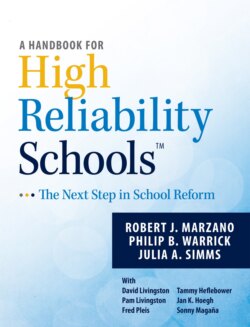Читать книгу A Handbook for High Reliability Schools - Robert J Marzano - Страница 19
На сайте Литреса книга снята с продажи.
How to Use This Book
ОглавлениеThis handbook has one chapter for each high reliability level. Each of these chapters begins with the recommended leading indicators for that level. We then present a series of surveys (for teachers and staff, administrators, students, and parents) based on those leading indicators. School leaders can use these surveys to get a preliminary idea of what leading indicators they may need to work on. Once members of the school community have completed the surveys and the results have been compiled, school leaders can identify which, if any, leading indicators need to be addressed in the school.
To address leading indicators, school leaders can use the critical commitments detailed in the chapter for each level: chapter 1 addresses how to implement the professional learning community (PLC) process; chapter 2 gives guidance about creating an evaluation system whose primary purpose is teacher development; chapter 3 speaks to continually monitoring the viability of the curriculum, creating a comprehensive vocabulary program, and using direct instruction in knowledge application and metacognitive skills; chapter 4 focuses on developing proficiency scales for essential content and reporting status and growth on the report card using those proficiency scales; and chapter 5 gives direction about getting rid of time requirements and adjusting reporting systems accordingly. These critical commitments can guide leaders as they work on areas identified by the leading indicator surveys.
If survey results indicate that no leading indicators need to be addressed, school leaders can move on to identifying lagging indicators and criterion scores that will be used to measure whether or not the school has achieved high reliability status for the level. To facilitate this process, each chapter provides a template that leaders can use to identify these indicators and scores, as well as example lagging indicators that school leaders could use. Once the lagging indicators have been created and the criterion scores set, school leaders gather data and other information to track their progress toward and achievement of high reliability status for that level.
Finally, each chapter lists specific questions (for quick conversations) and incidents (for quick observations) that school leaders can use to gather quick data for that level. Each chapter also provides examples of easy-to-collect quantitative data, which allow school leaders to continually monitor their school’s performance on previously achieved high reliability levels and celebrate success.
Figure I.4: High reliability schools process.
